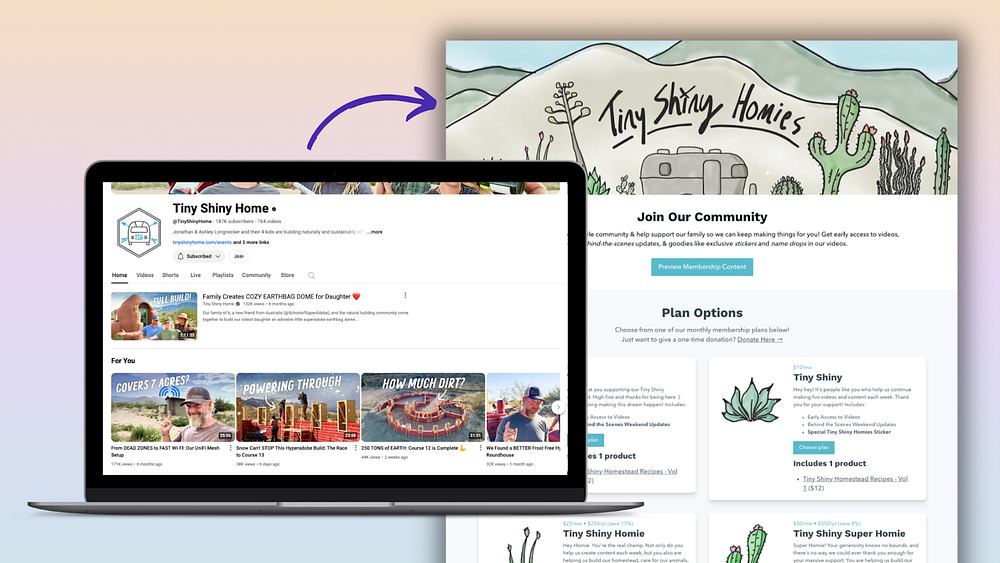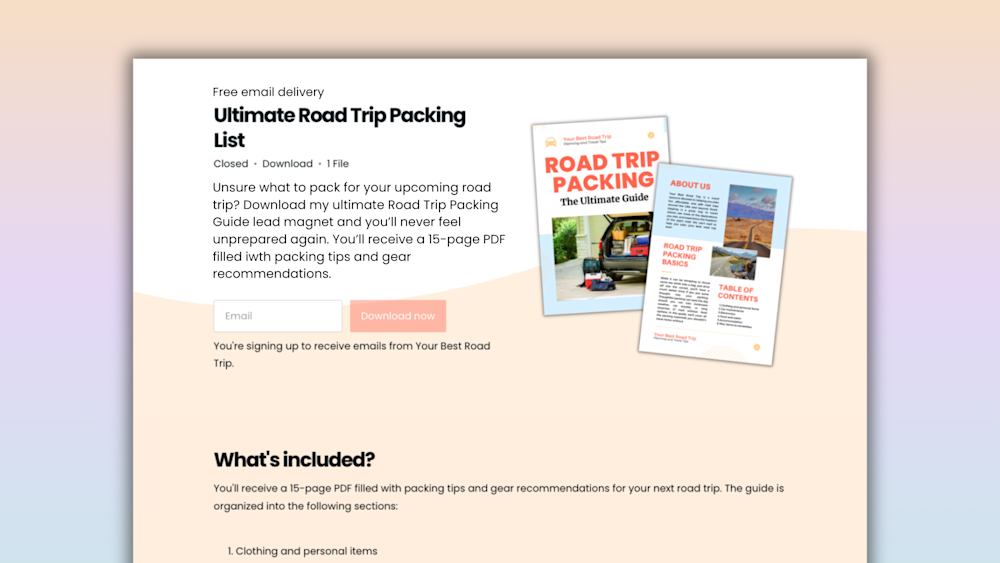You’re working hard to set up your first online business and take a moment to review all that’s on your checklist.
If you followed along with our roadmap in how to start an online business, the list probably looks like this:
-
Ask the hard questions before deciding to launch… ✓
-
Decide on a business model… ✓
-
Choose your product format… ✓
-
Set up your website… ✓
-
Explore resources and tools for automating your business… ✓
Nice -- you’re almost ready to go with your new online business.
As you get ready to launch, the only thing that’s missing now is your marketing plan.
We’ve got you covered.
Today, we share with you seven tips on how to brand, promote, and sell your online products, then go into how to sell without being pushy, and finish up with key ways to get referrals and retain your customers.
Sound exciting? Good, let’s get straight to your marketing strategies.
How do I brand, promote, and sell my online products?
#1. Create a consistently branded customer experience
To properly brand your online business, include consistent branding elements through your entire customer experience (CX), which means everything from your logo to your product pages. There's no entrepreneur branding rule more sacrosanct than consistency.
Even your email templates should have the same signature look and feel.
Why? Presenting your brand consistently is vital, and for that matter, profitable. Consistent brand presentation increases revenue by 23% on average.
Ideally, every touchpoint through your customer’s buyer journey should provide an obvious and visual connection to your business.
Here’s what I mean. Take, for example, this linear buyer journey map, where your customer interacts with your brand at various digital and physical touchpoints.
Any time someone interacts with your online business at any one of these touchpoints, they should know it’s your brand they’re interacting with.
Did they end up on your landing page? Your logo should be clear for them to find. Did they write into live chat? Your business name shouldn’t take more than a glance to identify.
While a lot goes into creating a well-designed website, the most important elements to land and unify are your logo, your brand colors, and fonts.
Take, for example, the VenturePOP site. From the product image to the logo treatment, everything feels like one cohesive experience thanks to the consistent styling.
You can follow in the footsteps of VenturePOP’s Ciera and Kristy and elevate your branding further by tying together your product images, CTAs, and buttons, as well.
Why the continued emphasis on color and consistency? Simple: Because combined, these two elements can increase brand recognition by 80%.
And with so many competitors out there -- over half a million new businesses open every month in the US -- that kind of recognition could be the difference between scaling or stagnating your business.
It’s likewise important to present consistent branding in your written copy, too, which brings us to our next tip.
#2. Tailor your email marketing specifically to your audience’s needs
To write copy that sells your new products, focus on your customers and prospective customers. Everything you write should be about your target audience’s emotions, pain points, and solutions to their problems.
After all, you’re in business to help them overcome their biggest problem. As business strategist Stephen Barnes from Byronvale Advisors puts it:
“Everything in business is about providing a solution to a problem.”
This applies to your email marketing in particular, as email marketing is one of the most impactful ways to increase your revenue.
One of the more conservative claims out there states the average return on investment (ROI) for email marketing is 3800% or $38 for every dollar you invest.
So, it’s crucial to get your email copywriting right.
An effective copywriting tip is to include the exact phrasing and wording from your audience in your messaging.
You know that market research you conducted to validate your business idea?
The info you gathered comes in handy here. Use the same language your target audience uses in your marketing copywriting and echo back their sentiments.
Co-founder of Firepole Marketing and creator of the Course Builder’s Laboratory, Danny Iny, calls this using your audience’s “problem language.” When hunting for problem language he recommends:
“Problem language is a great thing for you to listen for. When you see a lot of the same problem language in multiple places, make a note of it, keeping track of the exact words.”
You can use problem language in an email campaign as part of a sequence. This is especially useful if you’re selling online courses or other info products.
For instance, your first email in a five-email sequence might look something like this, where you agitate your audience’s problem with their own words as you introduce your brand.
This type of email is useful in building rapport and trust among your reader before introducing your digital product offer, as well. You can save your online course, or other popular digital product offers, for your fifth email after having nurtured your contact a bit more.
The main takeaway is to tailor your messaging to your audience’s needs and to use their own language whenever possible.
This encourages them to associate your brand as the solution to their problem, increasing the likelihood of a sale later on.
A compelling reason to create excellent content, right?
So is our next tip.
#3. Use content marketing to attract your target audience
Content marketing is one of the biggest priorities among marketers, making this a trusted way to attract new customers to your business.
The reason for this is content marketing is 62% cheaper than traditional marketing and outperforms with producing leads and conversion rates by far.
Part of the reason content marketing performs so well comes down to the credibility and trust it builds in audience. Creators who provide free valuable content, regardless of channel, establish themselves as experts on their topic and become trusted voices in their niche.
And how important is trust?
When it comes to making a purchase decision, exceedingly. More than one-third of adult consumers claim trust plays a significant role in their large purchase decisions.
So, as you plan out your editorial content calendar, make it a priority to build credibility through your content marketing by being accurate, actionable, and reliable.
If you’re just starting out and don’t have a broad audience following yet, one workaround is to reach out as a guest publisher to related businesses who already have an established following.
By offering to be a guest on their channel, you can provide valuable content to their audience, while gaining exposure to more relevant people.
Which means both parties benefit. Ideal, right?
Another useful tip to keep in mind with your content marketing is to write your content with search engine optimization (SEO) in mind. In other words, include keywords and phrases in your material to attract visitors searching for more info on that particular topic.
For example, check out these top articles that use keywords “women’s self-defense” in their blog posts to attract people looking for more info on the topic.
It’s worth noting when using SEO tactics, it’s important to work your keywords naturally into your content. If you’re writing to hit keyword density, you’re not likely to make much traction, but if you’re targeting user intent with your keywords, you’ve got a strong foundation for ranking.
(Want to build that foundation even higher? Swing by our article on blogging and SEO to get an in-depth look at how content and search engines work together to drive traffic. Or, if you're looking for even more nitty-gritty on SEO, check out these SEO tips.)
In sum:
When implementing your content marketing, it’s vital to publish valuable content regularly. This builds up your trustworthiness as a brand.
#4. Include testimonials and reviews to build your brand’s credibility
Another impactful way to increase sales is to build your brand’s social proof through customer testimonials and reviews.
With testimonials potentially increasing your page’s conversions by 270%, this is definitely a powerful method to use.
A good testimonial typically includes three characteristics:
-
Brief
-
Direct
-
Authentic
Check these out from project management tool, Basecamp, which contain all three qualities.
It’s also a best practice to include an image with your customer testimonial, like PPC agency, KlientBoost, does on their homepage.
Better yet, add video testimonials like these, also pulled from KlientBoost’s site, to bring your testimonials to life.
Alternatively (or in conjunction with), reviews are another great credibility-builder to include on your site.
When it comes to reviews, the higher the price of your product, the higher the conversion impact. When reviews are displayed for a higher-priced product, conversion rates increase 380%, whereas they increase 190% for lower-priced products.
However, as you can see, both price points score a significant boost, so it’s worth including reviews for all your products.
Typically, reviews include a rating with optional written feedback. To collect ratings and reviews, you can use feedback tools such as Promoter.io or AskNicely to create survey email prompts like what you see below.
Once your reader submits their rating, another form field shows up allowing for written commentary, though every platform has a different approach.
Pretty simple, yeah?
With your user’s permission, you have the option of posting the review on your site, but even without using them to show off some social proof, the results of surveys are great internal data to have to ensure your customers are satisfied.
If your ratings come back as less than ideal, you’ll know it’s time to iterate and improve your product or marketing.
But if you don’t have any customers to ask for feedback yet, don’t worry. You can always offer prospective clients a freebie or trial in exchange for a testimonial or review.
Here’s an example of an email template requesting a testimonial after their first experience using a brand’s product.
You can use this type of template for both paid and free trial users who are new to your product. Naturally, if the feedback is good, go ahead and publish to your site (again, after getting the user’s permission to do so).
If it isn’t as stellar as you’d like, act on it instead. There’s value in both outcomes.
The gist of it:
Ask your audience for feedback, whether testimonials or reviews, so you can publish them on your site, build brand credibility, and further entice sales.
#5. Tap into social media to expand your audience
You can use social media platforms, like Facebook, Instagram, Twitter, LinkedIn, and Reddit, to network and build rapport with your target audience.
After all, social platforms are still becoming increasingly popular. With an anticipated 3.02 billion global social media users by 2021, there are no signs of the user base slowing down.
Online forums and Facebook Groups that focus on specialized topics related to your business make for especially great data gathering and networking spaces.
To get started, simply peruse related online communities and social media platforms for networking opportunities.
For instance, in keeping with our “women’s self-defense” theme, a quick search in Facebook Groups reveals several related groups with numerous members in each, the most popular group boasting over 5,200 members.
Using this tactic to find and expand your audience is effective for two reasons:
-
It allows for social listening - In other words, it’s a form of market research where you can tune into relevant conversations and learn more about your audience’s problems. The more you learn, the better you can solve their pain points.
-
It provides an engaging platform - You can dive right in and start nurturing relationships with prospective clients by chiming in on discussions and providing value related to your topic.
Once you interact and build up a rapport with people within these social channels, you can then share more about your business and the solutions you provide.
Another impactful way to use social media is to post bite-sized and share-ready content on your own social channels.
Similar to your content marketing plan, it’s just a matter of creating a social media calendar where each post provides value to your audience.
Looking for an example? Check this out. Marketing tool, CoSchedule, offers its audience a live webinar on how to improve marketing project management.
It’s a small post -- little more than a line of copy -- but it provides access to valuable and audience-relevant content, making it an excellent contender for people’s attention.
If the idea of setting up a social editorial calendar sounds daunting, take heart. It’s easy to create your calendar and find your metrics if you align your content to your business objectives.
Plus, by defining various goals within your social media strategy, you can come up with content that speaks to a variety of stages in your audience’s buyer’s journey.
This keeps your business goals clearly defined and on track.
(Want more social media strategies? Check out Laura Roeder's tips for using social media to sell more digital products.)
Bottom line:
Using social media is a powerful way to expand your target audience.
A critical factor when conversing with your audience is to engage them by asking questions, paying attention to their desires, and by providing value.
Another way to leverage social platforms is through paid ads, which is to our next tip.
#6. Advertise to bring in revenue
For those of you with an ad budget, advertising is an effective way to bring in sales for your online business, or potentially even validate your online business ideas before you sink time and money into them.
Either way, once your business and budget grow, you can dive deeper into these digital advertising methods:
-
Social media ads - Virtually every social platform allows for paid advertising, sponsored ads, or boosted posts. With so many users on social platforms, you’re bound to find your target audience on social media.
As users are scrolling through their feeds, your ad can show up mixed in with their organic content, like this Facebook news feed ad from The Vector Lab.
-
Paid search ads - Also known as pay-per-click (PPC), these ads allow you to publish text-based ads related to specific keywords in search engines like Google, Yahoo!, and Bing.
When someone searches a relevant term, your ad can pop up around the search results like in this “marketing tools” query.
-
Native ads and sponsored content - These ads appear to be articles or blog posts nestled in larger publisher sites, like this one amidst other editorial HuffPost articles.
-
Banner and display ads - These are an extension of search ads and very similar to the PPC tactic. The difference is they display as images instead of text-based ads, like this Warby Parker ad below.
Regardless of the method or format you choose, the two most important factors when it comes to advertising are your offer and your audience targeting.
So, continue to test and tweak your ads -- both the messaging and who you’re reaching -- to find out which ads perform the best. Advertising allows for many things, but resting on your proverbial laurels isn’t one of them.
If you’re not interested in carving out an advertising budget as you start your online business, our final tip might be a better tactic for you.
#7. Run a referral or affiliate marketing program
Another proven way to bring in sales is to create a referral or affiliate marketing program, where you pay outside businesses a commission for sales made on your behalf.
With 81% of brands leveraging affiliate marketing, it’s an effective way for both you and your affiliates to pull in significant revenue.
From a publisher’s perspective, your referrers and affiliates can make anywhere from $2,000 a month up to over $25,000 a month.
If you’re curious about where to set your payout rate, the average commission rate is between 5% and 30% depending on your industry and product.
Outside of paying fair rates, another vital part of running your referral or affiliate program is to support your partners by providing them with helpful resources and frequent communication.
If you’re proactive in helping your affiliates sell your products, you’re ahead of the curve. Sadly, less than 25% of businesses promoted by affiliates provide the resources and creative materials they need to market their products.
OK, right about now, you’re probably wondering how difficult it is to set up an affiliate marketing program if they’re so widespread and potentially profitable.
The short answer is not difficult at all if you take advantage of an all-in-one platform like Podia.
Here’s what I mean. To create an affiliate marketing platform using Podia’s dashboard, you just scroll to the bottom of the “promote” tab under your “products” page and click on the “turn on affiliates” program.
You can then set your payment terms and commission amounts (using % or $) for each sale referred to you.
Voila -- simple as that, though if you want to get even more out of affiliate marketing, check out these affiliate marketing tips.
Now that you’re armed with proven marketing tactics, let’s wrap up with some sales tips.
How do I sell without being pushy?
If you want to sell your online products without coming off (or feeling) smarmy, inbound marketing should be your go-to solution.
Also known as attraction marketing, inbound marketing tactics focus on gifting value to your audience, so customers come to you instead of you chasing them down.
Creating and giving away content for free is a proven way to attract new customers to your business.
Lead magnets, in particular, are used to pull in new audience members and then to nurture a trusting relationship that leads to your offer. They come in all different formats, such as these popular types:
-
Checklists
-
Templates
-
Lists
-
Guides
-
Videos
-
Demos
-
Workbooks
-
Cheat sheets
-
Ebooks
-
Mini-courses
Check out creator Eldar Gezalov’s free Getting Started with Blocs 3 mini-course, which he uses as a lead magnet. In exchange for an email, Eldar gives away to his audience his mini-course for free.
This allows Eldar to send subsequent emails and messages to his audience that eventually promote his other product offers, like his paid digital downloads here.
Bonus tip: If you’re formatting a lengthy piece of content as a lead magnet, try to keep it to around seven minutes of reading time, or 2,000 words for an optimal length.
Extra bonus tip: If you’re looking for a convenient way to create a lead magnet, you may find this digital download generator useful. You simply fill out a few form fields and the generator pumps out a formatted downloadable PDF for you.
Easy-peasy, right? You provide something people want and people return the favor by giving you permission to market to them. It doesn’t get much more straightforward than that.
Additionally, as you implement inbound marketing, be sure to keep in mind the learnings from your market research.
By gleaning insights from your audience and honing in on their deepest desires, you can leverage what you learn to create content, products, and services they’re more likely to want and buy.
Again, you’re in business to serve your customers and solve their biggest problems. When you’re able to fully understand your customers’ problem and deliver an effective solution, the selling takes care of itself.
As do the referrals and retention, the final -- but no less important -- pieces of your marketing for a new online business.
How do I get referrals and retain my customers?
The best way to get referrals and retain your customers is to focus on their customer experience (CX) and prioritize their post-sale experience.
The better the CX, the greater your customer loyalty and number of purchases down the line.
Your loyal customers are more valuable than your prospective customers, and here’s why:
-
Loyal customers are your brand ambassadors - 60% of loyal consumers tell their friends and families about the brands they're loyal to.
-
They cost less - It can cost 5x more to acquire new customers than to keep your current ones.
-
They’re more likely to make repeat purchases and spend more - Your top 10% of loyal customers spend 3x more per order than the lower 90%, and your top 1% of customers spend 5x more than the lower 99%.
So, don’t make the mistake of underestimating the power of brand loyalty by disregarding the experience once the sale is made. Instead, do everything you can to grow a loyal customer base.
More specifically, focus on delivering an excellent product -- a base foundation -- and providing outstanding customer service and support. The latter is where you exceed your customer’s expectations.
Hubspot calls this “delighting your customer,” where your customers’ experience is so positive because you’ve far exceeded their expectations. When you’ve landed delight, customers naturally refer and promote your brand for you without you having to ask.
Sounds awesome, right?
Some of their -- and our favorite -- tips for delighting your customer are:
-
Be prompt and provide solutions to problems
-
Enable your customers to succeed
-
Take their feedback into account
-
Foster a community around your customers
I’d be delighted, too, if I received all this wonderful attention from a brand.
Basically:
To succeed in your business, don’t just meet customer expectations -- defy them and go above and beyond.
Springboard your first business launch with the right branding and marketing strategies in hand
These promotional tips are the final touches you need before officially launching your first online business.
Let’s review today’s tips:
-
To brand your online business, include consistent branding elements across every point where a custom interacts with your brand.
-
By tailoring your email marketing to your audience’s specific needs, you’ll build credibility and increase your chances for a purchase.
-
Content marketing is a powerful way to expand your target audience, especially if you deliver valuable and use SEO tactics.
-
Another great way to build your brand’s credibility is through testimonials, reviews, and networking on social media platforms.
-
To drive more revenue to your business, you can use a variety of paid ads or run a referral or affiliate marketing program.
-
Don’t neglect retention tactics, however. Retaining your customers over the long haul is just as important for your bottom line as bringing in new customers.
Hopefully, your checklist has a lot more checkmarks on it than blank spaces by now, but if finding the right hosting platform is still throwing you for a loop, you can put all of the tactics -- and many more -- you learned today in action with a free, no-obligation 2 week trial on Podia.
Happy launching!
(P.S.: Need more tips? Then swing by this guide on how to market your small business for even more actionable strategies.)



